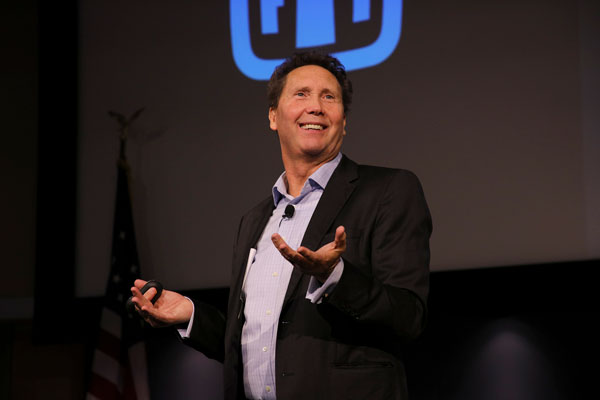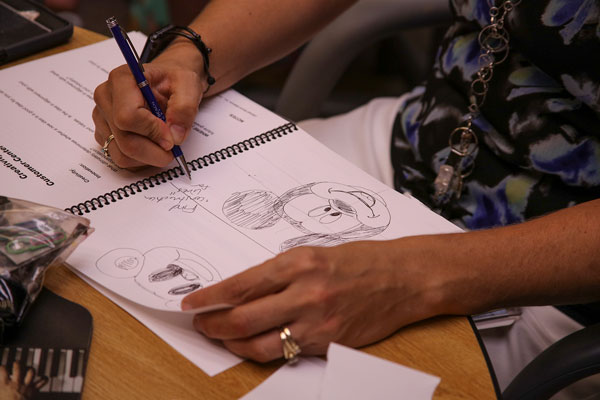How Disney uses creativity, imagination and engineering to orchestrate improvement

Who do you think is world class? What do they do that makes them different and better?
These are questions Mark David Jones, a former Disney executive and current president of Small World Alliance, posed to more than 300 Sandians gathered in the Steve Schiff Auditorium on Sept. 4 for the Imagineering World Class Results presentation sponsored by Sandia’s inclusion, diversity, EEO & AA organization. Jones shared behind-the-scenes insights on how Disney and other world class organizations consistently stay at the top of their game.
Behind the pixie dust and castles that come to mind when people think of Disney, Jones revealed that there’s a massive operation of 72,000 full-time employees working backstage to create a magical experience for each guest.
“What Disney and other world class organizations have done is take a generally complicated business situation and they’ve made the effort to distill it down to its essence without over simplifying it,” Jones said. “If it’s too complicated, it won’t get implemented.”
Imagineering performance excellence
When tasked with improving Disney’s operations, Jones turned to Imagineers, a group of people Walt Disney himself pulled together to combine creativity, imagination and engineering. Imagineers, he explained, take great ideas and bring them to life. They orchestrate any big improvement by working with everyone collectively to implement changes.
At the end of the day, Jones found that world class organizations need loyalty, advocacy and long-term success, which is determined by a “chain reaction of excellence” that begins with leadership.
“Here’s the thing about world class organizations I find really interesting,” he said. “They don’t define leadership as merely someone with direct reports. They define a leader as anyone who has influence over the culture.” Anyone can help create a culture of engagement with their colleagues in a way that focuses on exceeding customers’ expectations, Jones said. The customers then become advocates for the company, which leads to growth and impact.
Navigate with the Customer Compass
One tactic Jones shared to achieve success is the Customer Compass, a four-directional tool for understanding the people you work with by guiding you to their expectations, style, walk and needs. Whether working with internal colleagues and managers or external stakeholders and sponsors, the tool can help all employees connect, engage and better understand those they work with, he said.
First, it is important to know what your customers’ expectations are by having a discussion to understand what they really want. “You can’t exceed expectations until you know what they are,” he said. “Whatever you think your customers’ expectations are, you are probably aiming too low.”

Next, understand that people have different styles, similar to what the DiSC assessment characterizes as dominant, influential, steady or conscientious. These differences can make it more complicated and difficult to have effective working relationships, but “those differences are exactly what create the wow breakthroughs all the time,” he said. Thinking from different perspectives leads many world-class organizations to consistent, higher performance and better teamwork.
Once you understand your customers’ expectations and style, take a walk in their shoes, Jones said. Find out what they value and what their concerns are. “Instead of trying to be a hero to your customer, make your customer a hero to their customer.”
Finally, assess their needs. Jones said that everyone has five needs that get to the heart of human decision-making and behavior: to be heard and understood, to belong and contribute, to feel stable and in control, to feel significant and special and to reach their potential. He encouraged the audience to look for opportunities to meet those needs by trying to understand their customer’s perspective, finding common interests, providing options they can choose from, looking for opportunities to make them feel noticed and finding out what goals they aspire to achieve.
Deliver your promise with pleasant surprises
For an organization to deliver on its mission, it needs to pay careful attention to the experience that its people, places and processes create.
To emphasize how important people interactions are, Jones shared a story of a Disney resort housekeeper who carefully arranged children’s stuffed animals as if they magically came to life and had been playing in the room while the family was exploring the parks. The kids were so excited when they returned to the room that the family, who frequently vacationed at Disney, wrote a letter to Disney thanking them for the experience. The frontline people, Jones said, are the ones who directly or indirectly influence the value of a customer’s experience.
The environment also plays an important role, since attention paid to small details can make people wonder about attention paid to bigger, more important details, he said. At Disney, they use the phrase, “everything speaks” to describe how the five senses can pick up on how professional a place is, or the quality of service provided, right away.
Finally, efficient processes can make or break an experience, too. Instead of having executives come up with a solution to a problem, Jones emphasized the importance of involving the staff who are most familiar with the issue. “Let the people get involved who actually do the thing, and let’s work together as a team to come up with something that works, that exceeds the expectations of the people that we’re serving, and exceeds our internal expectations as a team,” he said. “That’s the whole key here: make it easy to do business with you.”
Be a leader, no matter your role
Whether you have a formal leadership title or not, Jones said the most successful leaders are the ones who emphasize influence over control. Be a trusted advisor by building relationships with trust and then use skills and abilities to credibly advise, he said.
Jones also said that world class organizations have a bias for action to gain buy-in, ownership and passion. “Let’s start a conversation, but more importantly, involve as many different perspectives as is appropriate, and then do something, actually take that first step,” he said. “To be extraordinary requires effort, and all of us individually have an influence on where this organization goes.”
Jones gave his presentation to employees on Sept. 4 and to managers on Sept. 5. Sandians who missed the presentation can view the video on the IDEA SharePoint site.